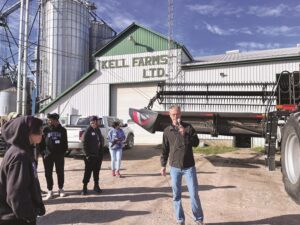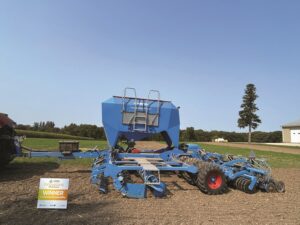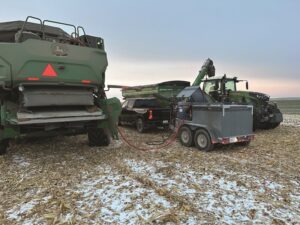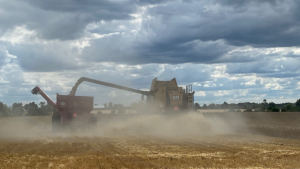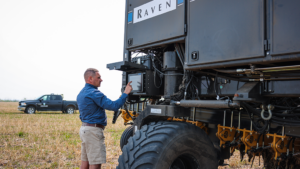Trucking troubles
Moving grain a challenge for Ontario farmers

Insurance limitations, onerous safety regulations, and driver shortages—these are some of the factors that have been increasingly troubling for grain growers in need of efficient trucking services. Here, stakeholders in Ontario’s grain sector share some of their experiences navigating the challenging transportation environment and what might be done to ensure things improve in future.
A RISK-ADVERSE INSURANCE INDUSTRY
As a former board member of one of Ontario’s largest farm mutual insurance companies, Quentin Martin, co-owner of Kitchener- area Cribit Seeds, says the digital era and data analytics have spurred insurance companies to continually assess complex risk. Consequently, they have become “very good at avoiding risk.”
“The irony is that, as businesses, we try to use insurance companies to manage our risk—as was [an insurance company’s] original purpose. This includes our farm and agriculture business insurance [for] property, casualty, liability, as well as truck fleets,” says Quentin.
“Most Ontario based mutual insurance companies don’t have the capacity, under their reinsurance structure, to write policies on large farms or ag business operations because the total insured value is too high.”
Quentin highlights human resources issues as another factor within the insurance industry, in that insurers often struggle to find qualified underwriters who understand large agricultural businesses. “Automating the underwriting process for this sector to be more cost effective is difficult because of the complexity and uniqueness of operations.”
“Large insurance companies don’t want to mess around in the space because it’s too niche. So, yes, agriculture-related insurance is a big issue,” Quentin says, referring to both large crop and livestock businesses. “We spend a lot of money on insurance and spent a lot of time last year changing insurance providers. We have grown and our previous providers have changed their ‘risk appetite’—and we were no longer an appropriate customer.”
NO INSURANCE FOR YOUNGER DRIVERS
For Craig and Jason Martin—co-owners of Cribit Seeds, Seeds, and CEO and equipment and equipment shop manager, respectively— the difficulty of finding grain truck drivers is compounded by the risk-aversion of insurance companies, particularly regarding younger operators.
“Years ago, we could start an individual on a D-class truck, then have them work their way into the A-class vehicles, as ready, without the expense of a third-party training organization,” says Craig. “The new training rules may prevent individuals from pursuing their A-licence in situations where they would be an occasional driver. In our case, if I found the right individual, we would consider putting them through the required training.”
Now, says Craig, insurance restrictions rule out most younger drivers for the A-class trucks. In the past, Cribit Seeds dealt with carriers unwilling to insure their summer students on pickup trucks.
“One will pay a significant premium to carry a new driver in their early twenties until they have a few years experience,” says Craig, adding his “casual observations” suggest more semi-trailers are “being pulled by farm tractors, where there is very little oversight on this activity.”
Cribit Seeds has been able to successfully navigate some of these roadblocks, however. The grain business currently has two dedicated full-time drivers, as well as part time seasonal drivers. Cribit Seeds’ owners also have their licences, meaning the company has a wide enough pool of people to draw from if regular drivers are not available or require flexibility. Without that pool, Craig says transport logistics would be much more complicated.
ONEROUS SAFETY REQUIREMENTS
Should trucks running short distances and largely seasonally be held to the same standards as daily long-distance highway haulers? According to provincial safety requirements, that is currently the case. According to Jason Martin, one of the concerns from such requirements is the cost to perform these inspections with Ontario’s Ministry of Transportation.
“Under previous legislation, depending on the braking system, the wheels did not have to be removed to complete a safety inspection. New legislation requires a “wheel off” inspection for all heavy-duty trucks and trailers. As you can imagine, on multi-axle units, this adds significant time and cost to perform the inspection,” Jason says. “For a farmer that only uses his truck and trailer a few months of the year, he must now decide if it’s worth owning it or having someone else haul his commodities.”
Crosby Devitt, Grain Farmers of Ontario’s CEO, agrees updated safety regulations might be overly onerous for trucks “not putting miles on everyday.” A second concern is the impact such regulations have on smaller garages, particularly those looking at transitioning to another operational generation. If the decision is made to close rather than deal with the headache of additional certification, options for getting trucks certified locally can diminish.
Devitt also questions how new drivers are supposed to gain experience in an environment where insurance providers do not, in fact, provide coverage.
“If you’re a big carrier with hundreds of trucks, there may be some ways they can spread out that risk,” says Devitt, adding he and others within Grain Farmers of Ontario have been made aware of policy differences between some insurance providers.
POTENTIAL SOLUTIONS
What actions can be taken on the part of grain farmers and grain haulers is not entirely clear. Devitt says active discussions are being held, though, and the Ministry of Transportation has been made aware of the agricultural industry’s concerns. Finding ways to align transportation regulations with those of other provinces has, for example, been floated as a potential regulatory remedy.
“What we’re asking for is that someone seriously digs in and works with us and the agriculture industry to see if there are some good solutions. No one wants to be unsafe on the road,” Devitt says, musing whether something like mileage limits could be accommodated before full safety regulations apply. Similar exemptions might be possible for young drivers and insurance- related barriers.
“There could be some ways to look at young drivers or limited distances, not going on the 401, who are going from the farm to the elevator and not into Hamilton…I know it’s really difficult to control those types of things, but something might be done.” •











